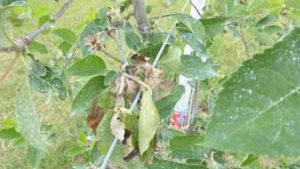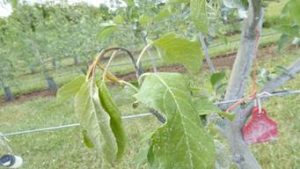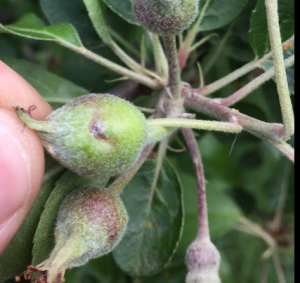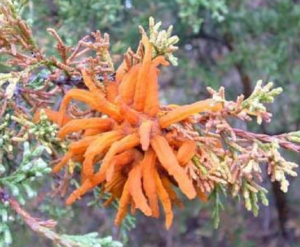By now virtually all orchards, including those in cooler regions, are at petal fall with only straggling bloom around on later cultivars. The cool weather has shut down concerns for continued blossom infections of fire blight. If infection did occur in your orchard during the May 18-20 warm spell (wouldn’t we love one of those again?), you should start seeing symptoms in your orchard around the middle of next week.
Figure 1. Blossom blight symptoms, 2016
Figure 2. Shoot blight symptoms, 2016
Orchards should have received a full-orchard petal fall insecticide by now or next spray. While things have been relatively quiet on the insect from this spring, a number of pests, including plum curculio (PC), European apple sawfly (EAS), and (maybe) codling moth (CM) are ready to pounce now. We have found fresh EAS and PC damaged un unsprayed or organically-managed trees at the UVM farm. If you are finding fresh damage on fruitlets in your orchard, consider application of a material that will cover both of those pests, and maybe CM too. This usually means a neonicotinoid like Assail or Actara; indoxacarb (Avaunt); or a pyrethroid, although the latter will be especially hard on predators and other beneficial insects. for organic growers, a pyrethrum application will help knock down PC that are already in the orchard but will have no residual efficacy- kaolin clay (Surround) sprays should be maintained until PC oviposition activity is complete. If you have already made you full-orchard application, then any subsequent sprays should be targeted at borders (PC, EAS) or at specific pests based on monitoring.
Figure 3. This PC damage is probably about a week old, notice the corking over and lack of sap exudate.
Codling moth are now flying in most Vermont orchards. Unless pheromone traps are checked daily, it is difficult to catch their exact first flight date, but based on captures in area orchards, I am using the following dates for sites around the state:
Brookfield: 5/23
Cornwall: 5/18
E Montpelier: n/a
Essex: 5/23
S Burlington: 5/17
S Hero: n/a
Shelburne: 5/18
Shoreham: 5/18
I would love a good catch date for some sites in southern Vermont if someone is trapping and could send them to me.
Those dates are important, because they represent the biofix that you would enter into NEWA for tracking degree day development to time CM-specific treatments. For most spray materials, timing should be targeted at about 250 degree days (base 43°F) from first catch. There is some room on either end of this, and that can account for differences between actual first flight and first catch in a trap, as well as to line up with good application weather on the other end. Based on the above assumed catch dates, most sites in the Champlain Valley have accumulated about 125 dd, and with the cool weather, we are accumulating 7-15 per day. Therefore, a targeted CM application should wait until next week anyway, we’ll follow up on that later. Specifically targeting CM sprays is a great IPM tactic for reducing impacts to non-target species, because selective materials that affect primarily lepidopteran pests (e.g., Altacor, Delegate, Intrepid) may be used at that time. However, Bt (Dipel, etc.) is relatively ineffective against CM when used as a targeted spray, its use against other lepidopteran pests is recommended but only provides supplemental management of this pest. Other ‘lep’ pests that are active include redbanded leafroller (larvae active) and obliquebanded leafroller (OBLR) (adults now flying). Your petal fall spray should have managed these for now, but if inspections of clusters are turning up larvae, a Bt spray may be warranted. For any material that has bee toxicity (e.g. most all except Bt, kaolin, or the lepidopteran-specific materials like Intrepid or Altacor), be sure to mow flowering plants in the groundcover prior to application.
For disease management, I recommend keeping at least one more fungicide on until you can scout for potential lesions from this last week’s rains. Despite NEWA’s proclamation that all overwintering apple scab inoculum was expended a week or more ago, I don’t trust it and feel it is too conservative in predicting the end of primary scab season. Scouting for detection of apple scab lesions (or lack thereof) to determine the end of scab management season should take place a couple of weeks from now to allow any infections to show.
While we’re in that weird period between the end of ascospore release and waiting for evidence of primary scab infection to show, we can still manage a couple of other diseases in the orchard. I am expecting cedar apple rust (CAR) to be particularly problematic this year, and powdery mildew (PM) infections can still occur on susceptible cultivars. We are nearing the end of the season for mancozeb fungicides- an application tomorrow gives an earliest harvestable date of August 18 to allow for residues to degrade- but those materials have excellent efficacy against CAR and none against PM (worst on Paulared and Cortland, among common cultivars grown in VT). Captan, the ‘standard’ fungicide used against scab, fruit rots, and cosmetic summer diseases, also has no effect on either CAR or PM. The SDHI (Fontelis, Luna, etc.), strobilurin (Sovran, Flint), and DMI (Rally, Procure, etc.) are all effective against those secondary diseases, even when the local apple scab population is resistant to them. This would be a good window to consider their use. For organic growers, I am not recommending much beyond sulfur, maybe lime sulfur if you need to provide some thinning. However, if fruit finish is not a concern, some work I did in the past two seasons indicates that low-dose copper (I used Cueva, but Badge or another material labeled for summer use should work) had some efficacy against CAR (we had no PM in the trial) but did cause some fruit russeting.
Figure 4. Cedar apple rust gall on cedar sent to me by my cousin in North Hero. These ‘telial horns’ are spreading spores that will infect apple now.
Thinning- it’s still tricky this year with this cool, wet weather. Remember that thinner activity is based on promoting a short-term carbohydrate deficiency in the tree, when too many developing fruitlets are calling for the limited sugars the tree is producing. Cloudy weather reduces net photosynthesis (increasing thinning); cool weather reduces respiration (reducing thinning). Cool weather also prevents hormonal 6-BA (Maxcel, Exilis) thinners from working best. For orchards that received a thinning spray last week, you should see activity from that now- fruits that will abscise have already stopped growing. For orchards that have not thinned yet, do it asap.
General recommendations are difficult to make; where fruit remained clustered up and a previous thinners was applied, OI would consider a low rate of NAA with or without carbaryl; where no thinners have been applied yet, carbaryl + a moderate (4 oz Fruitone N / 100 gallons tree row volume) should be used. For hard to thin cultivars with heavy set (Fuji, Liberty, Gala, Macoun), a higher rate of NAA or carbaryl + 6-B,A (the latter especially on Fuji and Empire) is called for. Fruit set and thinning activity should be checked every day or two at this point, where growers are using precision thinning methods and measuring fruit to gauge thinning activity, measurements every three days should suffice.
As I said last week, good luck- unfortunately this challenging spring hasn’t gotten any easier yet, but I think good weather (and the insects it brings) is just around the corner.
Where trade names or commercial products are used for identification,
no discrimination is intended and no endorsement is implied.
Always read the label before using any pesticide.
The label is the legal document for the product use.
Disregard any information in this message if it is in conflict with the
label.
The UVM Tree Fruit and Viticulture Program is supported by the
University of Vermont Agriculture Experiment Station, a USDA NIFA E-IPM
Grant, and USDA Risk Management Agency Funds.




